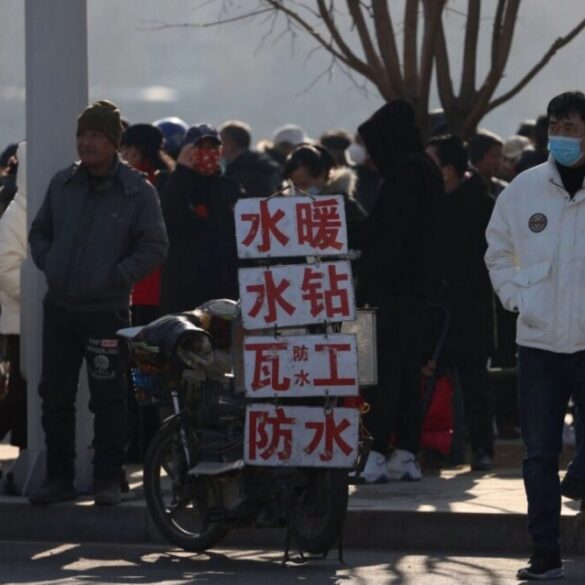The CCP has yet to lift 800 million out of poverty.

Migrant workers standing near signs advertising their skills as they wait by a street to be hired in Shenyang, in northeastern China’s Liaoning Province, on Feb. 6, 2023. (STR/AFP via Getty Images)

Commentary
Given the World Bank’s poverty level for China’s current income level, more than 40 percent of the population lives in poverty, while 80 percent are poor.
The myth of raising 800 million out of poverty has been perpetuated by the Chinese Communist Party (CCP) to legitimize its reign. The reality, however, is that the CCP, through its tight economic and social controls, kept people in poverty. This was evidenced by the Great Famine that arose in 1959 after rice farming was nationalized, resulting in as many as 30 million deaths, although the number could be higher. It was only in 1978, when Deng Xiaoping began opening the economy to market forces, that Chinese citizens began earning more money, and a middle class was eventually born. However, they were still poor. In the United States, the real GDP per capita, adjusted for inflation, was $4,000 in the year 1900, but China did not surpass that number until 2010.
Today, according to the International Monetary Fund, the U.S. GDP per capita is $85,300, while in China, it is only $13,100, ranking 74th in the world, lower than Mexico, Kazakhstan, and Malaysia. Beijing claims that only 0.04 percent of the population lives below the poverty line. However, the CCP uses a lower poverty threshold compared to international standards. The official poverty line is set at an annual income of 2,300 yuan (about $339.70) based on 2010 prices. This is significantly lower than the World Bank’s international poverty line of $1.90 per day.
If a higher income threshold is used, such as $12,000 per year, which better reflects the cost of living and economic conditions in modern China, it is estimated that around 40 percent of the population lives in or just above poverty. In fact, in 2021, 47 percent of the population lived on $10 per day or less. That number has improved somewhat since then but remains at about 40 percent. This threshold includes considerations for urban living costs, which are higher than in rural areas.
To put these numbers in context, China’s overall wealth today is about the same as that of the United States in 1960. At that time, the United States used a cutoff of $21.70 per day as the poverty line. By that measure, 80–90 percent of the Chinese population would be considered poor.
As low as the average income is in China, there is a stark difference between urban and rural incomes, with urban dwellers having 80 percent more disposable income than people in rural areas. The living standards are also dramatically different.
Rural dwellers are motivated to travel to the cities and work as migrant laborers to improve their earnings. China is estimated to have nearly 300 million migrants. The average salary for a migrant is between $525 and $722 per month, which is well below the national average. Because of the hukou, or household registration system, they and their children may lack access to public services such as health and education, and most fall outside of the national pension and disability schemes. Additionally, when these workers lose their factory jobs because of an economic downturn, as is happening now, they are not counted in the unemployment statistics. Consequently, the number of unemployed people and those living in poverty is much higher than the official data show.
Rural dwellers are motivated to travel to the cities and work as migrant laborers to improve their earnings. China is estimated to have nearly 300 million migrants. The average salary for a migrant is between $525 and $722 per month, which is well below the national average. Because of the hukou, or household registration system, they and their children may lack access to public services such as health and education, and most fall outside of the national pension and disability schemes. Additionally, when these workers lose their factory jobs because of an economic downturn, as is happening now, they are not counted in the unemployment statistics. Consequently, the number of unemployed people and those living in poverty is much higher than the official data show.
The other demographic with high rates of poverty is pensioners. Many Chinese pensioners receive inadequate pension benefits. The average pension payment in China in 2020 was less than $24 per month. The urban pension system covers retired workers in state-owned enterprises and public institutions. Still, rural dwellers are paid a fraction of what urban workers receive, and migrant workers may receive nothing.
Because of the aging population and low birth rate, China’s dependency ratio is increasing, with a dwindling number of working people supporting a growing number of pensioners. In 2022, there were 10 working people for each pensioner, but by 2030, the ratio is expected to hit 4 to 1. To reduce poverty among senior citizens, taxes on working people will have to be dramatically increased, which, in turn, will decrease their disposable income and lower their standard of living.
The CCP has chosen a lower poverty threshold to claim it has alleviated poverty. Now that it is becoming clear that real poverty in China is rising, the CCP is taking “poverty alleviation” measures that equate to more government intervention, further distorting the economy. Additionally, Beijing will have to divert government revenue from infrastructure and other development programs to increase pension and social payments to the poor.
As always, the CCP will tout its successes in raising people above its own low poverty line while suppressing data and dismissing the fact that many remain poor (but above the poverty level). Meanwhile, the average person in China has a much lower standard of living than people in developed countries.
The other demographic with high rates of poverty is pensioners. Many Chinese pensioners receive inadequate pension benefits. The average pension payment in China in 2020 was less than $24 per month. The urban pension system covers retired workers in state-owned enterprises and public institutions. Still, rural dwellers are paid a fraction of what urban workers receive, and migrant workers may receive nothing.
Because of the aging population and low birth rate, China’s dependency ratio is increasing, with a dwindling number of working people supporting a growing number of pensioners. In 2022, there were 10 working people for each pensioner, but by 2030, the ratio is expected to hit 4 to 1. To reduce poverty among senior citizens, taxes on working people will have to be dramatically increased, which, in turn, will decrease their disposable income and lower their standard of living.
The CCP has chosen a lower poverty threshold to claim it has alleviated poverty. Now that it is becoming clear that real poverty in China is rising, the CCP is taking “poverty alleviation” measures that equate to more government intervention, further distorting the economy. Additionally, Beijing will have to divert government revenue from infrastructure and other development programs to increase pension and social payments to the poor.
As always, the CCP will tout its successes in raising people above its own low poverty line while suppressing data and dismissing the fact that many remain poor (but above the poverty level). Meanwhile, the average person in China has a much lower standard of living than people in developed countries.
Views expressed in this article are opinions of the author and do not necessarily reflect the views of The Epoch Times.
Antonio Graceffo, PhD, is a China economic analyst who has spent more than 20 years in Asia. Mr. Graceffo is a graduate of the Shanghai University of Sport, holds a China-MBA from Shanghai Jiaotong University, and currently studies national defense at American Military University. He is the author of “Beyond the Belt and Road: China’s Global Economic Expansion” (2019).